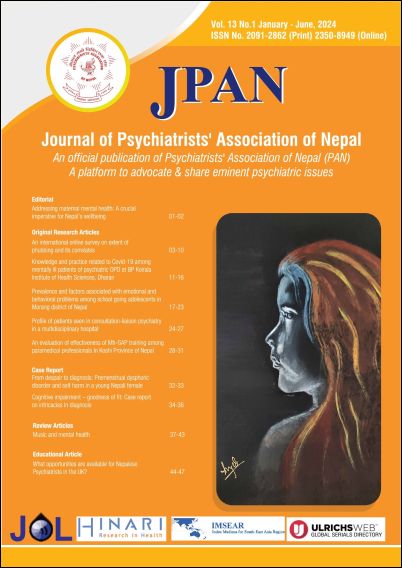From despair to diagnosis: Premenstrual dysphoric disorder and self-harm in a young Nepali female
DOI:
https://doi.org/10.3126/jpan.v13i1.68183Keywords:
Premenstrual dysphoric disorder, delibrate self-harm, PMDDAbstract
Up to 90% of women experience mild premenstrual symptoms and around 8% suffering from premenstrual dysphoric disorder (PMDD), which is often overlooked and linked to higher suicidal thoughts. This case involves a young woman who attempted self-harm by ingesting 10 tablets of mefenamic acid due to PMDD-related symptoms. A 21-year-old psychology student with no previous mental or chronic physical illnesses attempted self-harm by ingesting 10 tablets of mefenamic acid. She had been experiencing low self-esteem, anxiety, irritability, and emotional instability predictably each month before her menses since age 18. These symptoms led to feelings of worthlessness and suicidal thoughts, peaking just before her menstrual bleeding and subsiding afterward. On the day of her emergency room visit, intense guilt about past irritability triggered her self-harm. She was diagnosed with PMDD, prescribed fluoxetine, and showed improvement in her symptoms at the one-month follow-up. PMDD, characterized by hormone-related symptoms like mood swings and fatigue, affects 3-8% of menstruating women and can severely impact daily life. Studies highlight elevated rates of suicidal thoughts among women with PMDD, independent of other psychiatric conditions. In Nepal, a review of deliberate self-harm cases found that most incidents occurred in individuals under 35 years old, with suicides peaking between ages
20 to 25, yet PMDD was not identified as a contributing factor in any study. Research supports SSRIs as highly effective and well-tolerated treatments for PMDD, especially when used intermittently during the premenstrual phase, offering a promising therapeutic option.
Downloads
Downloads
Published
How to Cite
Issue
Section
License
Copyright (c) 2024 Journal of Psychiatrists' Association of Nepal

This work is licensed under a Creative Commons Attribution 4.0 International License.
This license enables reusers to distribute, remix, adapt, and build upon the material in any medium or format, so long as attribution is given to the creator. The license allows for commercial use.




